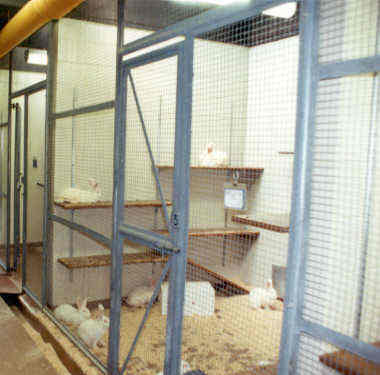Animal Advocates Watchdog
Regarding the issues of cage size and exercise for rabbits:
From the BC SPCA’s own website under the “Care of Rabbits” section:
“The amount of space your rabbit will need depends on the size and breed of your rabbit - the more space the better. Your rabbit’s hutch should be not less than 4 feet long by 3 feet wide by 2 feet high, raised above the ground. About 18" at one end should be boarded in for a sleeping room, with an opening large enough for the rabbit to go back and forth to the living and eating area. The living and eating area should have a full wire mesh front, with a door to open for feeding and cleaning with a strong latch to prevent dogs, cats and wild animals from getting in.
Remember that a rabbit needs time out of his cage/hutch for exercise every day.”
------------------------------------------------------------------------------------------
From the website of Susan A. Brown, DVM, on humane requirements for housing rabbits:
http://www.hrschicago.org/dietcarefr.html
“ENVIRONMENT
Cage
House rabbits should never be kept completely confined to a cage. Exercise is vital for the health of the rabbit. All too often we hear well meaning, but poorly informed, people describe rabbits as easy to keep because “they can be caged and don’t take up much space!” This idea has led to many rabbits being caged most of their lives with the distinct possibility of developing both physical and behavioral disorders. They are designed to run and jump and move about a large area.
To confine a rabbit to a cage exclusively can cause several problems:
•Obesity – caused most often by a diet too high in calories coupled with a lack of exercise
•Pododermatitis – Inflammation of the feet caused by sitting in a damp or dirty environment
•Poor bone density - Rabbits that are continually confined to a small cage can exhibit marked thinning of the bones which may lead to more easily broken bones when handling
•Poor muscle tone - If the rabbit can’t exercise, the muscles, including the heart, will be underdeveloped and weak
•Gastrointestinal and urinary function - A rabbit that sits all day in the cage with little exercise can develop abnormal elimination habits
•Behavioral problems - Continually caged rabbits can exhibit a wide range of abnormal behaviors including lethargy, aggression, continual chewing of the cage bars, chewing fur (obsessive grooming), and destruction of the entire contents of the cage.
_______________________________________________________
From the website of Anna Meredith MA VetMB CertLAS MRCVS, Royal (Dick) School of Veterinary Studies and Lance Jepson MA VetMB CBiol MIBiol MRCVS, University of Liverpool Small Animal Hospital:
http://www.aquavet.i12.com/Rabbit.htm
"Great care must be taken when handling rabbits. Osteoperosis is often present due to lack of exercise and low calcium intake, and a kick from the powerful hind legs can result in lumbar vertebral fractures (usually L6/L7). "
"Hutches should always be as large as possible, with at the very least sufficient room to fully stretch up on the hind limbs and stretch out. If confined to the hutch for long periods of time the rabbit should be able to perform at least three "hops" from one end to the other."
“An exercise area must always be provided in addition to hutch accommodation. This can be in the form of a mobile run or ark or a permanently fenced area of grass.”
__________________________________________________________
In looking at the photo with rows of cages at the Vancouver SPCA, I wonder why a different set up couldn’t be arranged for housing the rabbits? Many could be housed together and thereby provide them with more mobility, exercise room and social interaction.
What is the “exercise protocol” for the rabbits housed at the BC SPCA ? Can someone tell me? There must be written instructions in a care manual for staff.
Lana Simon, Director
Pacific Animal Foundation
Multi-rabbits pen

Messages In This Thread
- The SPCA, the Five Freedoms and Rabbits *LINK* *PIC*
- While focus is put on the inadequate cages no mention is made of the 10 excellent cages in the rabbit room *PIC*
- What kind of advocacy is that...sounds like she is an advocate for the SPCA
- I wish to make several comments with respect to the posting by VRRA President, Olga Betts
- How about some creative solutions for rabbit care? *PIC*
- While they may not be "suffering unduly" this does not justify an organization that "speaks for the animals" using this type of "housing" *PIC*
- I wish to make several comments with respect to the posting by VRRA President, Olga Betts
- You're all discussing whose form of cruelty is "better"
- What kind of advocacy is that...sounds like she is an advocate for the SPCA
- While focus is put on the inadequate cages no mention is made of the 10 excellent cages in the rabbit room *PIC*